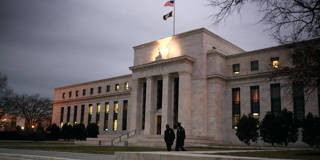Only accounting gimmickry is keeping the US Federal Reserve System’s total net capital in negative territory, raising the prospect that the Fed could someday require recapitalization. To ensure that such scenarios do not jeopardize its core mandates, US policymakers should take a page from their British counterparts’ playbook.
NEW YORK – On August 30, 2023, the US Federal Reserve System’s Consolidated Statement of Condition recorded total capital of $42.72 billion. This figure would have been negative but for the appearance of an $87.15 billion negative liability, driven by minus $95.12 billion in earnings remittances to be paid to the US Treasury. But make no mistake: this negative liability (known as a deferred asset) is an accounting gimmick that allows the Fed to avoid having to report negative total capital (equity or net worth) on its balance sheet.
The Fed explains this deferred asset as follows:
“The Federal Reserve Banks remit residual net earnings to the US Treasury after providing for the costs of operations, payment of dividends, and the amount necessary to maintain each Federal Reserve Bank’s allotted surplus cap. Positive amounts represent the estimated weekly remittances due to US Treasury. Negative amounts represent the cumulative deferred asset position, which is incurred during a period when earnings are not sufficient to provide for the cost of operations, payment of dividends, and maintaining surplus. The deferred asset is the amount of net earnings that the Federal Reserve Banks need to realize before remittances to the US Treasury resume.”

NEW YORK – On August 30, 2023, the US Federal Reserve System’s Consolidated Statement of Condition recorded total capital of $42.72 billion. This figure would have been negative but for the appearance of an $87.15 billion negative liability, driven by minus $95.12 billion in earnings remittances to be paid to the US Treasury. But make no mistake: this negative liability (known as a deferred asset) is an accounting gimmick that allows the Fed to avoid having to report negative total capital (equity or net worth) on its balance sheet.
The Fed explains this deferred asset as follows:
“The Federal Reserve Banks remit residual net earnings to the US Treasury after providing for the costs of operations, payment of dividends, and the amount necessary to maintain each Federal Reserve Bank’s allotted surplus cap. Positive amounts represent the estimated weekly remittances due to US Treasury. Negative amounts represent the cumulative deferred asset position, which is incurred during a period when earnings are not sufficient to provide for the cost of operations, payment of dividends, and maintaining surplus. The deferred asset is the amount of net earnings that the Federal Reserve Banks need to realize before remittances to the US Treasury resume.”